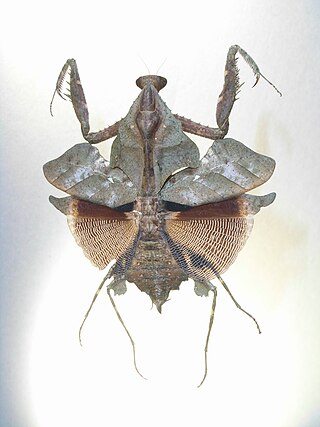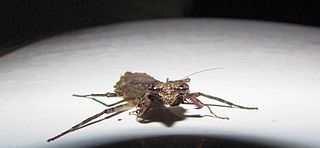
The Chinese mantis is a species of mantis native to Asia and the nearby islands. In 1896, this species was accidentally introduced by a nursery tender at Mt. Airy near Philadelphia, United States. Tenodera sinensis often is erroneously referred to as Tenodera aridifolia sinensis because it was at first described as a subspecies of Tenodera aridifolia, but Tenodera sinensis is now established as a full species.

The European mantis is a large hemimetabolic insect in the family of the Mantidae ('mantids'), which is the largest family of the order Mantodea (mantises). Their common name praying mantis is derived from the distinctive posture of the first pair of legs that can be observed in animals in repose. It resembles a praying attitude. Both males and females have elongated bodies with two pairs of wings. The most striking features that all Mantodea share are a very mobile, triangular head with large compound eyes and their first pair of legs, which is highly modified for the efficient capture and restraint of fast-moving or flying prey.

Mantidae is one of the largest families in the order of praying mantises, based on the type species Mantis religiosa; however, most genera are tropical or subtropical. Historically, this was the only family in the order, and many references still use the term "mantid" to refer to any mantis. Technically, however, "mantid" refers only to members of the family Mantidae, and not the 14 remaining families of mantises. Some of the most recent classifications have promoted a number of the mantid subfamilies to the rank of family, e.g. Iridopterygidae, Sibyllidae, Tarachodidae, Thespidae, and Toxoderidae, while other classifications have reduced the number of subfamilies without elevating to higher rank.

Miomantis caffra is a species of praying mantis native to southern Africa. It appeared in New Zealand in 1978, and was found more recently in Portugal and Los Angeles, USA, likely spread through the exotic pet trade. Females are facultatively parthenogenetic and unmated females can produce viable offspring.

Hymenopus coronatus is a mantis from the tropical forests of Southeast Asia. It is known by various common names including walking flower mantis and (pink) orchid mantis. It is one of several species known as flower mantises from their resemblance and behaviour. They are known to grab their prey with blinding speed.

Ant mimicry or myrmecomorphy is mimicry of ants by other organisms. Ants are abundant all over the world, and potential predators that rely on vision to identify their prey, such as birds and wasps, normally avoid them, because they are either unpalatable or aggressive. Spiders are the most common ant mimics. Additionally, some arthropods mimic ants to escape predation, while others mimic ants anatomically and behaviourally to hunt ants in aggressive mimicry. Ant mimicry has existed almost as long as ants themselves; the earliest ant mimics in the fossil record appear in the mid Cretaceous alongside the earliest ants. Indeed one of the earliest, Burmomyrma, was initially classified as an ant.

Iris oratoria, known by the common name Mediterranean mantis, due to humans first studying it in lands around the Mediterranean Sea, is a species of praying mantis. Its range is expanding in the Middle East, Western Asia and the United States.

Archimantis latistyla, commonly known as the large brown mantis is a species of mantid native to Australia. The large brown mantis has two subspecies, a widespread subspecies and the stick mantis ghost from Bundabergs Turtle Sands. The stick mantis ghosts are not as aggressive as the widespread species but have a defense display used to make the mantis appear larger by flinging its front legs into the air and putting its head down along with its antennae. Large brown mantids are light brown with short winged female and a long winged male. The subspecies from Bundaberg is a pale cream white with a yellow and black eye in between the arms. The large brown mantis female is short winged - her wings reach only half her abdomen and she is not able to fly— but the long winged male has wings that cover the entire abdomen. They have two pairs of wings - the top pair are the wing covers and the bottom wings enable the mantis to fly.

Brunneria borealis, common name Brunner's mantis, Brunner's stick mantis, or northern grass mantis, is a species of praying mantis native to the southern United States. It is the only mantis species known to reproduce solely through parthenogenesis; there are no males.

Hierodula patellifera, common name giant Asian mantis, Asian mantis, Indochina mantis or Harabiro Mantis, is a species of praying mantis belonging to genus Hierodula.
Deroplatys desiccata, known by the common name giant dead leaf mantis, is a praying mantis from Southeast Asia. This is the type species of genus Deroplatys.

Deroplatys lobata, common name Southeast Asian dead leaf mantis or dead leaf mantis, is a species of praying mantis that inhabits Thailand, Java, Borneo, Indonesia, Sumatra and the Malay Peninsula.

Gonatista is a genus of praying mantises in the family Epaphroditidae.
Gonatista major is a species of praying mantis native to the Caribbean and is found in Puerto Rico, Hispaniola, and perhaps elsewhere. In comparing G. grisea and G. reticulata in 2008, an entomologist with the United States Department of Agriculture wrote:
In general color this species is lighter than either of the preceding ones and is decidedly larger than either of them. The infuscation of the elytra is no more profuse than in grisea but is gathered in decidedly larger blotches, in this respect more like reticulata. The female is unknown to me. The measurements of the males are as follows: Length, pronotum, 13.5-14.5 mm.; elytra, 45-48 mm.
Gonatista phryganoides is a species of praying mantis discovered in 1839. According to an entomologist's account published in 1912:
This is the smallest member of the genus and is represented in the collection of the U. S. National Museum by a series of six males from San Francisco Mts., San Dorningo, W. I., taken in September,1905, by August Busck. Besides being much smaller than any other known species of the genus this differs from all others in the maculation of the elytra, which is here composed almost or entirely of small dots, no large elongate splotches being present as in the larger forms. I have seen no females of this species. The measurements of the males studied are as follows: Length, pronotum, 7.5-9 mm.; elytra, 26-28 mm.

Orthodera novaezealandiae, known as the New Zealand mantis or the New Zealand praying mantis, is a species of praying mantis which is, as both the scientific name and common names suggest, indigenous and endemic to New Zealand.

Acanthops is a genus of mantises in the family Acanthopidae, containing 20 species that can be found in Central and South America.

Mantises are an order (Mantodea) of insects that contains over 2,400 species in about 460 genera in 33 families. The largest family is the Mantidae ("mantids"). Mantises are distributed worldwide in temperate and tropical habitats. They have triangular heads with bulging eyes supported on flexible necks. Their elongated bodies may or may not have wings, but all Mantodea have forelegs that are greatly enlarged and adapted for catching and gripping prey; their upright posture, while remaining stationary with forearms folded, has led to the common name praying mantis.
Andrew Nelson Caudell was an entomologist who specialized in the study of grasshoppers and other insects in the order Orthoptera, becoming a prolific author of taxonomic studies, a member and president of the Entomological Society of Washington, and a fellow of the American Association for the Advancement of Science.

Titanodula is a genus of mantids in the subfamily Hierodulinae. There are currently five species placed in Titanodula. The genus is endemic to Asia and is distinguished from the similar genus Hierodula by the large size and unique male genitalia of its member species.














